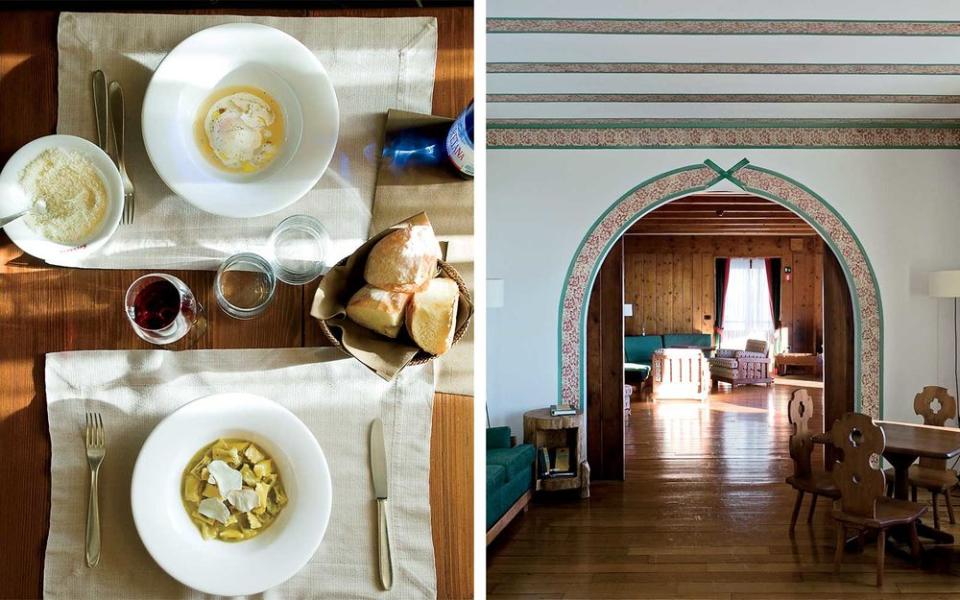Ski in Style at This Italian Mountain Chalet Run by a Famous Fashion House
From the window I could see for more than a hundred miles. Below me, in the near distance, were tiny villages following a winding road, little rivers of houses meandering down the hill. Beyond them the plains of northern Italy spread out as flat as a tabletop, and farther still were the Cottian Alps on the French border. It was something you might glimpse from a plane while climbing away from the airport. Instead, I was sitting down to lunch at the Albergo Bucaneve.
The local landscape informs almost everything about this hotel and spa in Bielmonte, a tiny resort high in the hills of Piedmont about 75 miles northwest of Milan. The Albergo Bucaneve (bucaneve is Italian for "snowdrop") sits at the heart of the Oasi Zegna, a 40-square-mile park owned and protected by Ermenegildo Zegna, the Italian menswear company whose factory has been based in the nearby town of Trivero since 1910. But despite its relationship with one of the world's leading luxury brands, the hotel is more responsive to flora and fauna than to fashion.
Opened in 1963, the Albergo Bucaneve was originally conceived as a restorative getaway that benefited the workers in Zegna's factory. Following World War II, Ermenegildo Zegna, the company's founder, had built a scenic road into the mountains called the Panoramica and later added the hotel, along with ski slopes, at its highest point. "It was his gift to the local people," says Anna Zegna, Ermenegildo's granddaughter, who now runs the Fondazione Zegna, the family's philanthropic organization.
To design the hotel, Ermenegildo chose Luigi Vietti, an Italian architect known for the stylish houses he fashioned for Cortina, a town in the Dolomites. Both the interiors and exterior of Vietti's building, which has remained largely unchanged since it opened, echo the old chalets and shepherds' dwellings that dot the landscape. Its bedrooms are cozy spaces lined with the spruce that grows on the hills; the sitting room and restaurant below are decked with the horns of the deer and chamois that roam the mountains. The only addition has been a spa, which was built in 2014 and expanded in 2016 to add a hot tub with a view through a giant picture window.
The hotel's rustic charms draw stressed-out Milanese looking for Alpine renewal. After breakfast there one morning, I headed out with Arturo Ramella, who was born near Bielmonte in 1963 and now works as a guide in the Oasi. The resort is an all-purpose playground for lovers of the outdoors. In winter you can ski down the slopes or through the valleys, or explore the network of paths on snowshoes. In spring and summer you can ride horses, go rock climbing, or admire the wildflowers that bloom all over the hills. But Ramella had a more meditative pursuit in mind for us: he was taking me "forest bathing."

The keepers of the Oasi have an almost hippieish devotion to trees. For centuries the forests had been exploited for timber, and the land had become denuded. So Zegna replanted more than half a million specimens. Today they are harnessed for therapy rather than fire. Forest bathing, a trend that originated in Japan, involves embracing the silence of the woodland — sometimes literally. As we walked through the valley, surrounded by firs and larches, we saw a set of steps leading to a platform in front of a large beech. A small sign invited you to hug the tree, and sure enough, there was a man in a red hat enjoying a lingering embrace. For anyone who, like me, finds the idea of absorbing a tree's "energy" mildly ridiculous, the forests hold other treasures. As Zegna's replanting took hold, animals that had been chased out by the logging came back. For the first time in a hundred years, you can hear the howls of wolves.
The landscape is the source of the Albergo Bucaneve's culinary pleasures as well as the Oasi's natural ones. That evening I sat down with chef Giacomo Gallina, who is at the start of his first season at the Albergo, following stints in Singapore, Paris, and Milan, and whose food is a reason to visit in itself. Gallina cleaves to a simple rule: he only cooks produce from the land he can see from the window. Happily, he can see a long way. Dinner that night took in the whole terrain, starting with anchovies sourced from Liguria's fish markets before moving on to veal cheeks from Piedmont, cooked long and slow, that were soft enough to eat with a spoon. I was visiting in December, and as I ate, snow carpeted the Panoramica outside. Cutting into my chocolate dessert, its rich center oozing out and saucing a fan of caramelized pears, I hoped the road would become impassable and I'd be stuck here for a few more days. Doubles from $179.
Content in this article was produced with assistance from Albergo Bucaneve and Ermenegildo Zegna."

